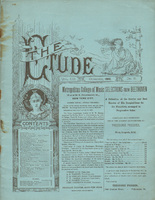BY WILHILM KIENZL.
The creating or composing by a musician is the greatest puzzle to the layman. How often the question was asked of me, “How do you manage to hold on to a musical thought and to put it on paper so anybody can play or sing it just as you had thought it out? How, where, and when comes to you a musical impression—a melody? How is it possible with one thought to encompass all the instruments of an orchestra and to make note of it all? Do you have first the musical idea, and then look up a text or poetry for it, or is it vice versa?”
For such inquiries it is very hard to give correct answer, especially if it is to satisfy the questioner. Such questions are seldom asked of painters, sculptors, or architects. While the creative action of these artists differs not from that of a poet or a musician, outsiders harbor the idea that it is easier to paint a picture than to compose a symphony or an opera. This childlike view can be understood, inasmuch as the musician is the only artist who does not borrow his forms from his surroundings, but from his inner self.
The way the composers receive their first ideas is as different with each individual one as are the physiognomies or handwritings of the people in general. Without external impression there can be no creative ideas, although it may not appear to be so. It is even possible that such ingrained idea comes to an artist without his knowledge, as this may happen while he is in dreamland. But exterior or inner life experiences are always the incentive for creative work. It may be of interest to learn something of the different manner in which old or contemporaneous musicians compose their music, also their habits while composing, and of the external influences which were necessary to do the work.
To get into the right mood Sarti needed a large room lighted softly with but one lamp. Paër composed his largest works (“Sargino,” “Achilleus”) while talking to strangers, quarreling with his wife, punishing his children, or contending with servants. Salieri walked through the most frequented quarters of the city with slate and pencil, to be able to note at once some happy impression; he was always chewing candy. Gluck, in order to translate himself to Tauris or Erebus, wanted the fresh air of the meadow, flooded in sunshine and sipping champagne. Cimarosa preferred to work while in joyous company, surrounded by noise; in this way resulted his “Secret Marriage,” and this is a reminder of Mozart, who wrote his exquisite E flat major trio for piano, clarionet, and viola in a bowling alley during a lively game of ninepins, hence the name Bowling Alley Trio (Kegelstatt-Trio) by which the composition is often called, or of Schubert, who wrote the sketch of most of his dances and songs in the inn in the midst of a cheerful crowd. Paësiello composed only when in bed; his best work, “La Molinara,” was written in that way. This makes me think of Robert Hamerling, who often received me at noon while still in bed, with the explanation that the muse came to him more readily in that position. The cause for this may be physiological, as the recumbent position of the body undoubtedly is favorable to the activity of the brain.
According to Schindler, it was in the bath tub, early mornings, where Beethoven received his highest inspirations. Zingarelli, who composed while sitting at the piano, always sought previous inspiration by reading some church work or Latin poet; after that his work progressed with giant strides. Haydn sat quietly in his chair thinking, but it was indispensable that a ring given him by Frederick II was on his finger, so that his thoughts could become clear and unfold.
Various are the accounts of how decided inspirations were begotten for the composition of some works. Carl Czerny reports that Beethoven received his musical idea for the scherzo of the Ninth Symphony from the chatter of the sparrows in the garden. Another version has it that Beethoven sat long into the night in the open air, when the thousands of glittering lights gave him the idea for the scherzo. It is told of Weber that he received his inspiration for the march in “Oberon” by seeing in a beer garden the chairs piled one on the other! Goldmark is said to have been impressed by the song of a lark at Carlsbad for the singular and bewitching call of Astaroth in the second act of his “Queen of Sheba.” These matters are not to be laughed at. Extravagant as they seem, they contain the elements to make them important.
There exist physical secrets which cannot lightly be brushed aside. Fechner has thrown a light in his “Phychaphysik” on these singular evidences, which to sober mankind appear crazy, or at least fathomless mysteries. Who can decide what combination of direct or indirect impressions and thoughts have been the underlying idea of Richard Wagner’s creations? His predilections for silk and velvet, for rugs and curtains, and for their decided colors is well known. His study at his last home in the Palace Vendramin at Venice was wholly in pink.
It would be going too far to enumerate the many impressions that were necessary to musicians to accomplish their work. But of this we are certain: that they needed them and that they were individual with each of them. On this one’s mind acts the roaring of a stream, the noise of carriage wheels, of machinery, the ticking of a clock; on another only the greatest quiet and solitude will produce the right frame of mind for the reception of ideas. One wants sunlight, others, the night. Many can only work in the morning, others again only in the evening.—Neue Deutsche Rundschau.



